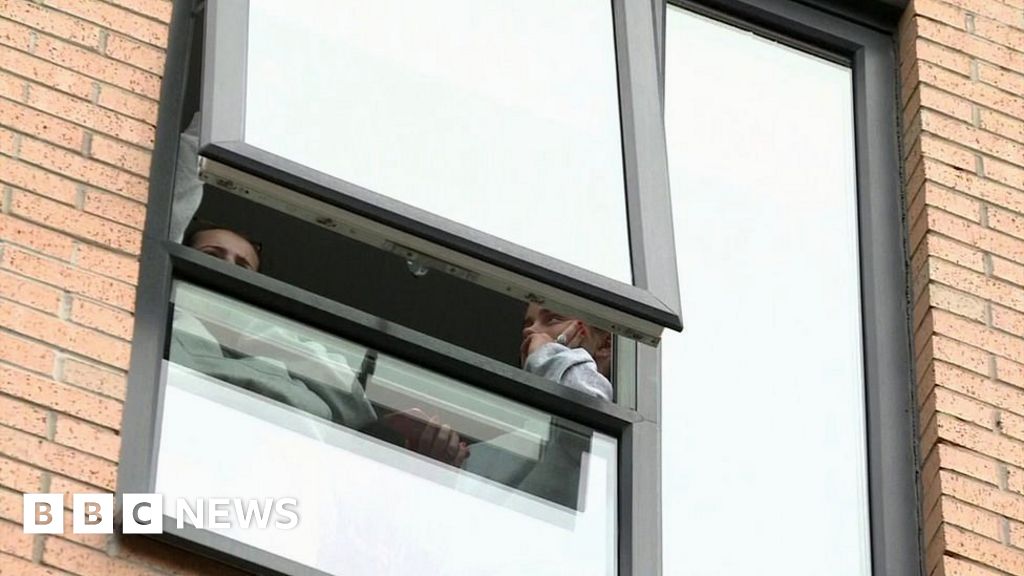Published2 minutes ago
image copyrightGetty Images
A-level students in England, Wales and Northern Ireland will have their grades based on teacher assessments rather than an algorithm, after uproar on last week's results day.
Teachers' grades will also be used for Thursday's GCSE results in England, and in Northern Ireland and Wales.
How were A-level grades originally decided?
Students in the UK did not sit exams this year because schools were closed following the coronavirus lockdown.
In England, A-level students were given grades by the official exam regulator, Ofqual.
Teachers were asked to supply for each pupil:
These were put through an algorithm - or mathematical procedure. The biggest element in that was the school's performances in each subject over the previous three years.
The idea was that the grades this year - even without exams - would be consistent with how schools had done in the past.
The teachers' rankings would decide which pupils received the top grades in their particular school.
Ofqual said this was a more accurate way of awarding grades than simply relying on teachers' assessments.
It argued that teachers were likely to be more generous in assigning an estimated mark, and this might lead to grade inflation - a much higher number of pupils getting the top grades.
Similar algorithms were applied for A-level pupils in Wales and Northern Ireland. They were also used in Scotland for the Scottish Higher qualification, which is broadly comparable with A-levels.
What happened?
When A-level grades were announced in England, Wales and Northern Ireland on 13 August, nearly 40% were lower than teachers' assessments.
There were similar issues in Scotland.
In England, 36% of entries had a lower grade than teachers recommended and 3% were down two grades.
What's more, the downgrading affected state schools much more than the private sector.
The prime minister defended the system as "robust", but there was widespread criticism from schools and colleges, as well as from the opposition and some Conservative MPs.
Why did some schools feel they had been treated unfairly?
Ofqual said that its objective for A-level results was to ensure that national results were "broadly similar to previous years".
However, by basing it so much around previous school performance, a bright student from an underperforming school was likely to have their results downgraded through no fault of their own.
Likewise, a school which was in the process of rapid improvement would not have seen this progress reflected in results.
In Scotland, figures showed that the Scottish Higher pass rate for pupils from the most deprived backgrounds was reduced by 15.2 percentage points, compared with only 6.9 percentage points for the wealthiest pupils.
Why did it benefit private schools?
Private schools are usually selective - and better-funded - and in most years will perform well in terms of exam results. An algorithm based on past performance will put students from these schools at an advantage compared with their state-educated equivalents.
There was a further factor at work according to statisticians Philip Nye and Dave Thompson of FFT Education Datalab. They said class sizes in independent schools are usually significantly smaller than in state schools.
Where there were fewer than five pupils studying a subject at a school, their grades were decided only on the basis of teachers' estimates.
Where there were between five and 15 entrants for a subject, teachers' assessments would still be given more weight.
Were there other protections in place?
A-level students in England, Wales and Northern Ireland all had their original grades informed by algorithms.
However, some other protections were in place or later added:
In Scotland, after criticism over the Higher results, the government reverted to teacher assessed grades.
What happens next?
It isn't entirely clear yet.
Some students will now have higher grades, so might consider looking at different universities or colleges. The process for doing so hasn't been outlined in full and pupils should keep in contact with their schools and Ucas, the university admissions system.
Ucas has said that more than two-thirds of pupils already had their first choice of university before the government U-turn happened.
However, they add that for those who now have the grades to get into their first choice, their first step should be to speak to their school and then the university they want to go to.
Alistair Jarvis, the head of the university body Universities UK, has said they "will do everything they can" to help students over the next few days. However, he has also highlighted the "challenges" facing universities, such as capacity, staffing and facilities.
It also means that this year will see a considerable amount of grade inflation, the main reason the algorithm was introduced in the first place.
Grade inflation is when grades increase substantially, making it difficult to compare one year with another. This can cause problems, because students from this year might compete with students from previous years for jobs, apprenticeships or university places.

 5 years ago
1065
5 years ago
1065 
